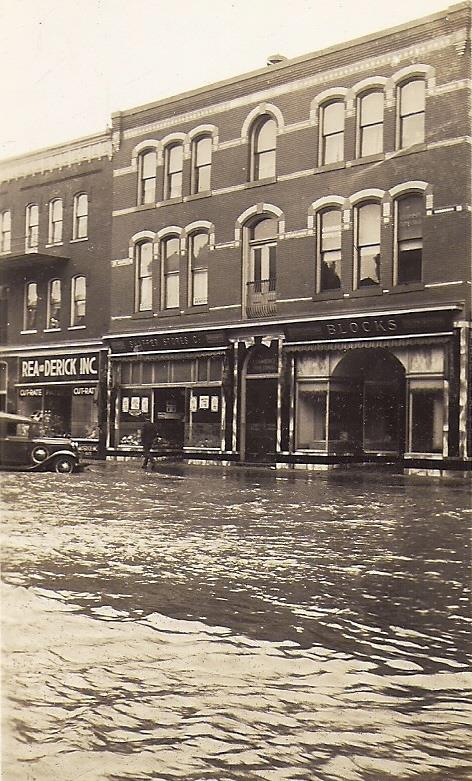In Central Pennsylvania, few disasters linger in the memories of our communities like the St. Patrick’s Day flood of March 17, 1936.
The winter of 1935-36 was particularly harsh, and had seen historic snowfall and low temperatures across January and February. A week prior to St. Patrick’s Day, Central Pennsylvania was blanketed with 2 to 3 feet of snow, followed by an abrupt change in the weather. Historic lows gave way to historic highs, and 60-degree temperatures rapidly melted the deep snowpack. With so much snowmelt, streams and rivers swelled. Only one more ingredient was necessary to create a potentially dangerous situation: rain.
On March 12, snow transitioned to steady rain. Over the next five days, more than 4 inches of precipitation drenched the already over-saturated area. Along the Susquehanna, flooding was already ravaging communities along the river. Waterways in Centre and Blair counties that were on the verge of flooding quickly swelled in kind, setting up a disastrous Monday, March 17 — St. Patrick’s Day.
In most communities, the day started like any other soggy March day. Although concerned about the rising rivers, the distraction of St. Patrick’s Day was on the minds of many in Central PA. By noon in towns like Tyrone, the gravity of the situation was finally realized. Church bells and school bells rang, alerting a state of emergency. Flooding occurred so rapidly in Lock Haven that many became trapped inside downtown buildings as they watched the water climb. Streets in town became unnavigable, forcing many first responders to turn to boats to reach those in need. Railways became unusable, phone lines that had been inundated with emergency calls went dead, and towns became isolated, left to manage the deluge alone.

As darkness fell and rains continued, concerns in Bellefonte turned to McCoy’s Dam above Milesburg. One local, Charles Eminhizer, was swept from the dam in the night as he attempted to open the flood gates and was lost to the raging waters, and others feared that the dam might give way entirely, causing more casualties in the village below. In Tyrone, the paper mill’s store of lumber along Bald Eagle Creek was swept away, snowballing down the waterway and taking out cars, sheds, bridges, and even two houses. A largely Irish community just outside of Birmingham along the Little Juniata River called the “Irish Flats” was completely erased from the map.
The amount of water that flooded these communities was staggering. Tyrone saw water crest nearly 10 feet above street level at the corner of Pennsylvania Avenue and 10th Street. The Susquehanna crested at over 29 feet, and most of Lock Haven was reported as “submerged.” Communities were abandoned as people ran, quite literally, for the hills.
It wasn’t until late the following day that the waters began to recede. A pair of Penn State students, whose school had escaped with minimal damage, traveled 112 miles around Centre County to recount the devastation. As they left State College toward Philipsburg, they noted that many bridges were out, and Philipsburg’s eastern and western edges were impassable. In Clearfield, they saw a “half-mile-wide” lake appear along Daisy Street near the river. Debris littered every roadway, and many they passed along the road were hauling boats to help rescue those who were still stranded. They also reported that the Black Moshannon, normally a picturesque stream, was a raging 200-yard-wide river. All the homes the students passed on their journey had been flooded, and most were abandoned.
By the time waters receded to a manageable level, many towns saw the true impact of the flood. Several victims across Central PA were discovered, thousands lost their homes, businesses were destroyed, and entire communities were reshaped. Statewide damages were estimated to cost over 100 lives and more than $300 million.
In many communities across the region, stories have been passed down of heroism, bravery, and struggle stemming from the St. Patrick’s Day flood of 1936. In a world where we love to use monikers like “storm of the century” and “historic” to describe events occurring around us, the flood of 1936 serves as a true reminder of nature’s devastating power. T&G
Local Historia is a passion for local history, community, and preservation. Its mission is to connect you with local history through engaging content and walking tours. Local Historia is owned by public historians Matt Maris and Dustin Elder, who co-author this column. For more, visit localhistoria.com.
Sources:
2 student tourists describe flood conditions in county. (1936, March 19). Centre Daily Times, pp. 1–6.
The floods of March 1936. (n.d.-b). https://pubs.usgs.gov/wsp/0799/report.pdf
Sickler Ohl, S. (1991, March 16). St. patrick’s day flood of 1936 remembered. Tyrone Daily Herald, pp. 1–2.
State College, Pennsylvania Seasonal Snowfall. (n.d.-a). http://climate.met.psu.edu/wxstn/PICS/SCESnow1887-2014.pdf
US Department of Commerce, N. (2016, March 16). 1936 flood retrospective. National Weather Service. https://www.weather.gov/lwx/1936Flood




